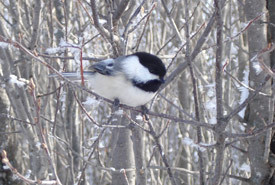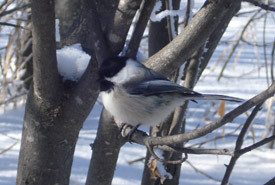Do Chickadees Fly South For The Winter? The answer is no, chickadees don’t migrate south for the winter. These resilient birds have developed remarkable strategies to survive even the harshest conditions, showcasing their incredible adaptability and making them a familiar sight in backyards across North America. If you’re curious about how these tiny birds manage to thrive in freezing temperatures, flyermedia.net offers fascinating insights into their winter survival techniques. Uncover the secrets of chickadee resilience, from their unique food caching habits to their ingenious thermoregulation methods, and discover how these avian wonders conquer the cold. Delve deeper into the world of chickadees with details on their food storage, winter flocking and their ability to stay warm.
1. Understanding Chickadee Winter Survival
1.1. What Makes Chickadees Unique?
Chickadees are small, energetic birds found throughout North America. Unlike many other bird species, they are year-round residents, meaning they don’t migrate south for the winter. This makes them a familiar sight in many backyards, even when the weather turns frigid. Their ability to survive the winter is a testament to their remarkable adaptations and resilience.
1.2. Why Don’t Chickadees Migrate?
The decision to migrate is often driven by the availability of food and suitable breeding conditions. For chickadees, their diet primarily consists of seeds, insects, and berries. While insect populations dwindle in the winter, chickadees have developed strategies to access stored food and adapt their diet to survive. According to a study by the Cornell Lab of Ornithology, chickadees’ ability to remember thousands of cached food locations allows them to thrive even when food is scarce.
1.3. What Challenges Do Chickadees Face in Winter?
Chickadees face numerous challenges during the winter months. The most significant challenges are:
- Extreme Cold: Chickadees must maintain a high body temperature to survive freezing temperatures.
- Food Scarcity: Insects, a primary food source, become scarce, requiring chickadees to rely on stored food.
- Predation: Chickadees are vulnerable to predators like hawks and owls, especially when foraging for food.
- Short Daylight Hours: Reduced daylight limits the time available for foraging and storing food.
2. How Chickadees Stay Warm
2.1. Feather Insulation: The Natural Jacket
One of the most critical adaptations for winter survival is feather insulation. Bird feathers are excellent insulators due to their structure, which traps air close to the bird’s body. On cold days, chickadees fluff up their feathers to maximize this layer of warm air. This behavior creates an adorable “puffball” effect, making them appear larger and rounder.
2.2. Shivering: Generating Heat Internally
Shivering is another vital mechanism for generating heat. When temperatures drop, chickadees shiver their muscles, producing heat that warms their bodies. This process requires a significant amount of energy, highlighting the importance of having access to sufficient food reserves.
2.3. Roosting in Sheltered Spots
Chickadees often seek shelter in tree cavities, dense vegetation, or even birdhouses to escape the worst of the winter weather. These sheltered spots provide protection from wind and help conserve body heat. According to research from the University of Wisconsin-Madison, chickadees can lower their body temperature slightly at night to conserve energy, a state known as regulated hypothermia.
2.4. How Do Chickadees Keep Warm at Night?
At night, chickadees find sheltered roosting spots in tree cavities, dense shrubs, or birdhouses. They also enter a state of regulated hypothermia, lowering their body temperature to conserve energy. This unique adaptation allows them to survive long, cold winter nights. As reported by the National Audubon Society, chickadees can reduce their body temperature by as much as 10-12 degrees Fahrenheit.
3. Chickadee Diet and Food Caching
3.1. What Do Chickadees Eat in the Winter?
In the winter, chickadees primarily rely on seeds, berries, and stored insects. They are opportunistic feeders and will also visit bird feeders to consume suet, nuts, and other provided foods. Their ability to adapt their diet based on availability is crucial for survival.
3.2. Food Caching: The Secret to Winter Survival
Food caching is a remarkable behavior where chickadees store food in numerous hidden locations during the fall and winter months. They create these caches by tucking away seeds and insects in crevices, under bark, and in other concealed spots. Each chickadee can create thousands of caches and remember the location of each one for months.
3.3. How Do Chickadees Remember Their Caches?
Chickadees have an extraordinary spatial memory, allowing them to recall the location of thousands of food caches. Research has shown that their hippocampus, the part of the brain responsible for spatial memory, actually grows larger in the fall and winter months, when caching behavior is most prevalent. According to a study in the journal “Brain Behavior and Evolution,” this growth is temporary and the hippocampus shrinks again in the spring.
3.4. The Role of Bird Feeders in Chickadee Survival
Bird feeders can play a significant role in supporting chickadee populations during the winter. By providing a reliable source of high-energy foods like sunflower seeds and suet, feeders can help chickadees maintain their body weight and energy reserves. However, it is important to keep feeders clean to prevent the spread of disease.
4. Social Behavior and Flocking
4.1. Why Do Chickadees Form Flocks in Winter?
Chickadees form flocks in the winter for several reasons:
- Protection: Flocks provide safety in numbers, making it more difficult for predators to single out an individual.
- Information Sharing: Flocks allow chickadees to share information about food sources and potential dangers.
- Social Interaction: Flocking provides opportunities for social interaction and maintaining social bonds.
4.2. How Do Flocks Help Chickadees Survive?
Being in a flock means there are more eyes on alert for danger. The larger the group, the lower the odds that any one individual will become a victim to predators. Flocks also facilitate the sharing of information about food sources. If one chickadee discovers a productive feeding site, it can lead the rest of the flock to the same location.
4.3. Dominance Hierarchies in Chickadee Flocks
Chickadee flocks are organized around dominance hierarchies, with some individuals having higher social status than others. Dominant birds typically have priority access to food and roosting sites, while subordinate birds may face more competition. These hierarchies help to maintain order within the flock and reduce conflict.
4.4. Chickadee Communication
Chickadees are highly vocal birds, using a variety of calls to communicate with each other. Their most well-known call is the “chick-a-dee-dee-dee” song, which serves multiple functions, including alerting others to danger, maintaining contact within the flock, and establishing territory. The number of “dee” notes in the call can also indicate the level of threat, with more “dees” signaling a greater danger.
5. Physiological Adaptations
5.1. Regulated Hypothermia
As mentioned earlier, chickadees can enter a state of regulated hypothermia at night, lowering their body temperature to conserve energy. This adaptation is particularly useful during long, cold winter nights when food is unavailable. By reducing their metabolic rate, chickadees can minimize energy expenditure and survive on limited reserves.
5.2. High Metabolic Rate
Chickadees have a high metabolic rate, which allows them to generate heat quickly. However, this also means they need to consume a lot of food to maintain their energy levels. The combination of a high metabolic rate and the ability to regulate body temperature is crucial for surviving extreme cold.
5.3. Specialized Blood Vessels
Chickadees have specialized blood vessels in their legs and feet that help to minimize heat loss. These vessels are arranged in a countercurrent exchange system, where warm blood flowing to the extremities passes close to cold blood returning to the body. This allows heat to be transferred from the outgoing blood to the incoming blood, reducing heat loss and preventing the feet from freezing.
5.4. The Impact of Climate Change on Chickadees
Climate change poses a growing threat to chickadee populations. Changes in temperature and precipitation patterns can affect food availability and habitat suitability. Warmer winters may reduce the effectiveness of food caching, while extreme weather events can disrupt breeding and foraging activities. According to the National Wildlife Federation, it is important to protect and restore habitats that support chickadee populations and to take action to reduce greenhouse gas emissions.
6. Chickadee Habitats
6.1. Ideal Chickadee Habitats
Chickadees thrive in a variety of habitats, including deciduous and mixed forests, woodlands, parks, and suburban gardens. They prefer areas with plenty of trees, shrubs, and dense vegetation, which provide food, shelter, and nesting sites. Chickadees are also attracted to areas with bird feeders and water sources.
6.2. Nesting Habits
Chickadees typically nest in tree cavities, either natural holes or abandoned woodpecker nests. They will also use birdhouses if available. The female chickadee builds the nest, using materials like moss, feathers, and animal fur to create a soft, insulated lining. The nest provides a safe and warm place for the chicks to develop.
6.3. How to Attract Chickadees to Your Yard
You can attract chickadees to your yard by providing the following:
- Bird Feeders: Offer sunflower seeds, suet, and peanuts in feeders.
- Water Source: Provide a birdbath or other water source, especially during dry periods.
- Native Plants: Plant native trees, shrubs, and flowers that provide food and shelter.
- Nesting Sites: Install birdhouses or leave dead trees standing to provide natural nesting cavities.
- Shelter: Maintain dense vegetation and shrubs to offer protection from predators and harsh weather.
6.4. Supporting Chickadee Conservation Efforts
There are many ways to support chickadee conservation efforts:
- Participate in Citizen Science Projects: Join programs like Project FeederWatch to monitor bird populations and contribute valuable data to researchers.
- Support Conservation Organizations: Donate to organizations that work to protect bird habitats and promote conservation.
- Practice Sustainable Gardening: Use native plants, avoid pesticides, and conserve water in your garden.
- Advocate for Conservation Policies: Support policies that protect bird habitats and address climate change.
7. Chickadee Conservation Status
7.1. Current Population Trends
Chickadee populations are generally stable across their range. However, some local populations may be declining due to habitat loss, pesticide use, and other factors. Monitoring chickadee populations is important to identify potential threats and implement effective conservation strategies.
7.2. Threats to Chickadee Populations
The main threats to chickadee populations include:
- Habitat Loss: Deforestation, urbanization, and agricultural expansion can reduce the availability of suitable habitat for chickadees.
- Pesticide Use: Pesticides can harm chickadees directly or indirectly by reducing the availability of insects, their primary food source.
- Climate Change: Changes in temperature and precipitation patterns can affect food availability and habitat suitability.
- Predation: Chickadees are vulnerable to predators like hawks, owls, and domestic cats.
- Disease: Outbreaks of diseases like West Nile virus can impact chickadee populations.
7.3. Conservation Strategies
Effective conservation strategies for chickadees include:
- Habitat Protection: Protecting and restoring forests, woodlands, and other habitats that support chickadee populations.
- Sustainable Land Management: Promoting sustainable forestry, agriculture, and urban development practices that minimize impacts on bird habitats.
- Pesticide Reduction: Reducing the use of pesticides and promoting integrated pest management strategies.
- Climate Change Mitigation: Taking action to reduce greenhouse gas emissions and mitigate the impacts of climate change on bird populations.
- Predator Control: Managing predator populations, especially domestic cats, to reduce predation pressure on chickadees.
7.4. How Can You Help Chickadees?
You can help chickadees by:
- Providing Food and Water: Offer sunflower seeds, suet, and water in your yard.
- Creating Habitat: Plant native trees, shrubs, and flowers to provide food, shelter, and nesting sites.
- Avoiding Pesticides: Use natural pest control methods and avoid using pesticides in your yard.
- Keeping Cats Indoors: Prevent cats from hunting birds by keeping them indoors.
- Supporting Conservation Organizations: Donate to organizations that work to protect bird habitats and promote conservation.
8. Frequently Asked Questions (FAQs) About Chickadees
8.1. What is the lifespan of a chickadee?
The average lifespan of a chickadee is about 2-3 years, but some individuals can live longer in the wild.
8.2. How do chickadees find food under the snow?
Chickadees rely on their excellent spatial memory to locate cached food items, even when they are buried under snow.
8.3. Do chickadees mate for life?
Chickadees typically form pair bonds that last for a single breeding season, but they may choose the same mate in subsequent years.
8.4. Are chickadees territorial?
Chickadees are territorial during the breeding season, defending their nesting territories from other chickadees.
8.5. What is the chickadee’s call?
The chickadee’s call is a distinctive “chick-a-dee-dee-dee” song, which is used for communication, alerting others to danger, and establishing territory.
8.6. How many eggs do chickadees lay?
Chickadees typically lay 6-8 eggs in a single clutch.
8.7. How long do chickadee chicks stay in the nest?
Chickadee chicks typically stay in the nest for about 16-19 days before fledging.
8.8. What predators eat chickadees?
Chickadees are preyed upon by hawks, owls, snakes, and domestic cats.
8.9. Do chickadees use birdhouses?
Yes, chickadees will readily use birdhouses for nesting, especially if they are placed in suitable locations.
8.10. What is the difference between male and female chickadees?
Male and female chickadees look very similar, but males tend to be slightly larger and have more pronounced black markings on their throats.
9. Fascinating Facts About Chickadees
9.1. Brain Growth
Chickadees have the ability to grow new brain cells, which helps them adapt to changing environments and improve their spatial memory.
9.2. Vocal Mimicry
Chickadees can mimic the calls of other birds, including predators, which may help them to deter threats or attract mates.
9.3. Adaptable Diet
Chickadees are highly adaptable in their diet, consuming a wide variety of insects, seeds, berries, and other foods depending on availability.
9.4. Winter Flocking
Chickadee flocks can include other bird species, such as nuthatches and woodpeckers, which benefit from the increased protection and information sharing.
9.5. Research Contributions
Chickadees have been the subject of numerous scientific studies, providing valuable insights into bird behavior, ecology, and conservation.
10. Conclusion: Appreciating the Resilient Chickadee
The black-capped chickadee is a remarkable bird, showcasing incredible adaptations to survive the harsh winter months. From their insulating feathers and shivering behavior to their food caching abilities and social flocking, chickadees have evolved a range of strategies to thrive in challenging conditions. By understanding and appreciating these adaptations, we can better support chickadee populations and contribute to their conservation.
Visit flyermedia.net to learn more about chickadee behavior, habitat, and conservation efforts. Explore our resources for attracting chickadees to your yard, participating in citizen science projects, and supporting organizations that are dedicated to protecting these resilient birds. Discover a wealth of information about aviation training, aviation news, and career opportunities in the aviation industry.
Are you passionate about aviation? Flyermedia.net is your go-to source for aviation insights. Whether you’re seeking flight training, staying updated on aviation news, or exploring career paths, we have you covered. Contact us today at 600 S Clyde Morris Blvd, Daytona Beach, FL 32114, United States or call +1 (386) 226-6000. Let flyermedia.net be your guide as you take flight in the world of aviation.
 Black-capped chickadee perched on a branch during winter
Black-capped chickadee perched on a branch during winter
 Fluffy chickadee perched in a tree
Fluffy chickadee perched in a tree
